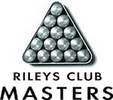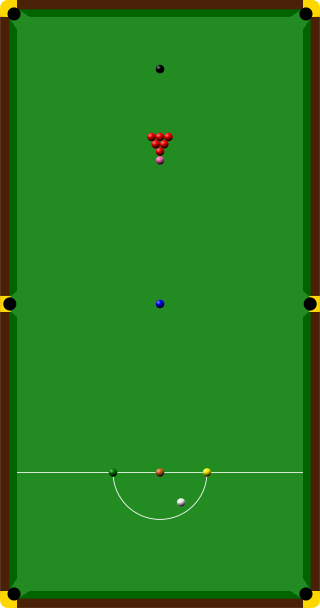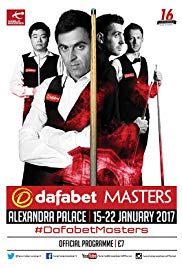
Cue sports are a wide variety of games of skill played with a cue, which is used to strike billiard balls and thereby cause them to move around a cloth-covered table bounded by elastic bumpers known as cushions. Cue sports are also collectively referred to as billiards, though this term has more specific connotations in some varieties of English.

Nine-ball is a discipline of the cue sport pool. The game's origins are traceable to the 1920s in the United States. It is played on a rectangular billiard table with pockets at each of the four corners and in the middle of each long side. Using a cue stick, players must strike the white cue ball to pocket nine colored billiard balls, hitting them in ascending numerical order. An individual game is won by the player pocketing the 9-ball. Matches are usually played as a race to a set number of racks, with the player who reaches the set number winning the match.

Snooker is a cue sport played on a rectangular billiards table covered with a green cloth called baize, with six pockets, one at each corner and one in the middle of each long side. First played by British Army officers stationed in India in the second half of the 19th century, the game is played with twenty-two balls, comprising a white cue ball, fifteen red balls, and six other balls—a yellow, green, brown, blue, pink, and black—collectively called the colours. Using a cue stick, the individual players or teams take turns to strike the cue ball to pot other balls in a predefined sequence, accumulating points for each successful pot and for each time the opposing player or team commits a foul. An individual frame of snooker is won by the player who has scored the most points. A snooker match ends when a player reaches a predetermined number of frames.

English billiards, called simply billiards in the United Kingdom and in many former British colonies, is a cue sport that combines the aspects of carom billiards and pool. Two cue balls and a red object ball are used. Each player or team uses a different cue ball. It is played on a billiards table with the same dimensions as one used for snooker and points are scored for cannons and pocketing the balls.

Straight pool, which is also called 14.1 continuous and 14.1 rack, is a cue sport in which two competing players attempt to pocket as many object balls as possible without playing a foul. The game was the primary version of pool played in professional competition until it was superseded by faster-playing games like nine-ball and eight-ball in the 1980s.

A maximum break is the highest possible break in snooker in normal circumstances and is a special type of total clearance. A player compiles a maximum break by potting all 15 reds with 15 blacks for 120 points, followed by all six colours for a further 27 points. Compiling a maximum break is regarded as a highly significant achievement in the game of snooker, and may be compared to a nine-dart finish in darts or a 300 game in ten-pin bowling.

Russian pyramid, also known as Russian billiards, is a form of billiards played on a large billiard table with narrow pockets. It is played across Russia and several former Soviet/Eastern Bloc countries. In the West, the game is known as pyramid billiards, or simply pyramid.
The following is a glossary of traditional English-language terms used in the three overarching cue sports disciplines: carom billiards referring to the various carom games played on a billiard table without pockets; pool, which denotes a host of games played on a table with six pockets; and snooker, played on a large pocket table, and which has a sport culture unto itself distinct from pool. There are also games such as English billiards that include aspects of multiple disciplines.

In snooker, a century break is a break of 100 points or more, compiled in one visit to the table. A century break requires potting at least 25 consecutive balls, and the ability to score centuries is regarded as a mark of the highest skill in snooker. Ronnie O'Sullivan has described a player's first century break as the "ultimate milestone for any snooker player".

Snooker is a cue sport that is played on a baize-covered snooker table with pockets in each of the four corners and in the middle of each of the long side cushions. It is played using a cue and snooker balls: one white cue ball, 15 red balls worth one point each, and six balls of different colours: yellow, green (3), brown (4), blue (5), pink (6), black (7). A player wins a frame of snooker by scoring more points than the opponent(s), using the cue ball to pot the red and coloured object balls. A player wins a match when they have achieved the best-of score from a pre-determined number of frames. The number of frames is always odd so as to prevent a tie or a draw.

The English-originating version of eight-ball pool, also known as English pool, English eight-ball, blackball, or simply reds and yellows, is a pool game played with sixteen balls on a small pool table with six pockets. It originated in the United Kingdom and is played in the Commonwealth countries such as Australia and South Africa. In the UK and Ireland it is usually called simply "pool".
The 2004 Masters was a professional non-ranking snooker tournament held in February 2004. It was the 30th staging of the Masters tournament, one of three Triple Crown events on the Snooker Tour, the eighth of fifteen World Professional Billiards and Snooker Association (WPBSA) events in the 2003/2004 season, and was held at the Wembley Conference Centre in London, United Kingdom from 1 to 8 February 2004. The tournament was broadcast in the United Kingdom by the BBC.

The 2005 Masters was the 2005 edition of the non-ranking Masters professional snooker tournament. It was held from 13 to 20 February 2005 at the Wembley Conference Centre, London. The tournament was the 31st staging of the competition and was the sixth of nine World Professional Billiards and Snooker Association (WPBSA) main tour events in the 2004/2005 season. The tournament was broadcast in the United Kingdom on the BBC and by Eurosport in Europe.

Sinuca brasileira, often simply called sinuca, is a cue sport played on a snooker table, using only one red ball instead of snooker's fifteen, with the normal six colours of the standard set of snooker balls. Each ball carries the same basic point value as in snooker. As with other pocket billiards games, a white cue ball is used to pot the red and other coloured balls. The game is played almost exclusively in Brazil and is little known outside this region.
Carom billiards and pool are two types of cue sports or billiards-family games, which as a general class are played with a stick called a cue which is used to strike billiard balls, moving them around a cloth-covered billiard table bounded by rubber cushions attached to the confining rails of the table.

Six-red snooker, is a variant of snooker, but with only six red balls initially on the table as opposed to the standard fifteen.
Tenball was a cue sports tournament that was staged only once, in 1995. It was a hybrid of snooker and pool rules and gameplay, played on a snooker table with snooker balls. An ITV/LWT TV series Tenball, hosted by Phillip Schofield, ran for one 1995 series, forming an eight-man tournament, ultimately won by Jimmy White.

The 2017 Masters was a professional non-ranking snooker tournament that took place from 15 to 22 January 2017 at Alexandra Palace in London, England. It was the 43rd staging of the Masters and the second Triple Crown event of the 2016/17 snooker season, following the 2016 UK Championship and preceding the 2017 World Snooker Championship.
The 2010 Power Snooker was a cue sports tournament. The inaugural event took place on the 30 October 2010 at The O2, London, United Kingdom. Ronnie O'Sullivan defeated Ding Junhui 572–258 on points in a 30 minute time based unlimited racks final.
The 2020 World Snooker Championship was a professional snooker tournament that took place from 31 July to 16 August 2020 at the Crucible Theatre in Sheffield, England. It was the 44th consecutive year that the World Snooker Championship was held at the Crucible. The final ranking event of the 2019–20 snooker season, the tournament was originally scheduled to take place from 18 April to 4 May 2020, but both the qualifying stage and the main rounds were postponed as a result of the COVID-19 pandemic. The event was one of the first to allow live audiences since the onset of the pandemic, but on the first day it was announced that the event would be played behind closed doors for subsequent days. A limited number of spectators were allowed in for the final two days of the championship.
















